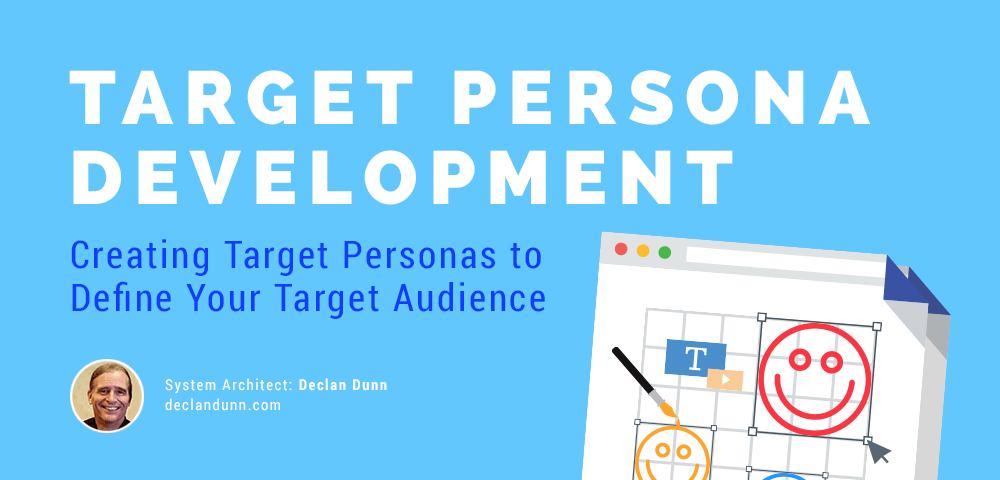System Architect | Declan Dunn: declandunn.com
What’s the most effective way to give your business marketing campaign a solid direction? The practice of developing target audience personas whereby successful entrepreneurs learn and better understand the different types of customers who fall within their objective.
Personas are fictional characters which are based on real data gathered through market research. They are different from your target audience who usually represent behavioural tendencies, a range of demographics and raw statistics.
For example, your target audience can tell you that male entrepreneurs between 20 to 40 years old read through your business website posts. On the other hand, your target audience personas will tell you that they’re startup entrepreneurs who quit their jobs to pursue their passion.
Having access to persona information allows you to save money and time when making – and marketing – products and services so that are perfectly suited for your target market.
Keen to get started? Follow this three-step process by Declan Dunn (connect with him here) that will help you define three personas with ease.
Identify Your Target Audience – Overview
- The diversity of your market is usually divided into 60% one person, 30% another and 10% the other.
- To personalise the lead process, focus on developing the 3 personas.
- Who: age, gender, demographic of your audience.
- Where: their location and online habits.
- Key challenges: understand and define their problem.
- Messaging: where and how do they learn and communicate.
Step 1: Persona development through search and trigger words
- What trigger words does your audience use to describe their problem, What are people searching for?
- Go to SerpStat.com enter a keyword or competitors URL. Look for the way people describe what they’re looking for and what words are used repeatedly. Note: These words are ideal to use in your own marketing.
- Gather the top 10 initial keywords from organic search, and the top 10 keywords from Paid Adwords (Pay Per Click) results. Compare your customer’s keywords to your competitors Adwords keywords.
- What are the top search results?
- Research the the Top 10-20 listings; are they competitors? or/are are there terms that make the results muddled?
- Use AHREFS.com find out who links to these top results, how many link, and how they link (blog posts, reviews, events, etc.)
- What questions are your customers asking?
- These questions form the core of your copy, as well as content you’ll develop for your web site and social media. Identify the most important questions to your target audience and focus on these.
- What content is your competition sharing?
- Use this to determine if you should create similar content, different content, and/or simply update their old content.
- Determine where in the funnel this content is being used – top of the funnel is for introductory information, middle is for education, and bottom of the funnel is for sales and conversion.
Step 2: Persona development through social channels
- What social channels are most active for your audience?
- Define which social channels are used by your audience, and what time of day they frequently use it. This helps to identify which social channel will you focus on?
- Who are the influencers and connectors who bring people together?
- Build a list of important, influential and connected people in social media and engage with them. Watch what type of content they are already sharing with your audience.
- Which competitors are actively marketing on social media?
- Keep a list of the headlines and marketing campaigns you find with your competition. What time of year do they run these, and why? What words create most engagement?
- Which articles are popular?
- Research what types of articles rank highly, get shared, and have most engagement. Categorise these based on social media channel – does content tend to perform better on one channel or across a combination.
- Use photos and videos, plus small infographics, ad creative photos, and other graphics.
- Suggestion! Use BuzzSumo.com find the most shared content and key influencers.
Step 3: Persona development through messaging by the numbers.
- Bring your keywords lists, headlines, and content from step 1.
- Rank these based on organic search first and pick out the top 3 messages you’ve found.
- Integrate your lists of social influencers, connections, and content from step 2.
- Rank these by popularity and engagement, while also watching which companies lead in social. Get clear who the Influencers are; what content they published that touched the audience, and when did the post it (month/year)?
- Create/define your 3 key Personas
- Who: age, gender, demographic of your audience.
- Where: their location and online habits.
- Key challenges: help them understand and define their problem.
- Messaging: where and how do they learn and communicate.
- Personalise headlines, keywords, and messaging for each of your 3 key Personas on search and social media.
- Develop tailored marketing for each Persona – you’re looking to tailor beyond just a name… add location, who they work for if relevant, and other info that will catch their attention.
How to Measure Success
- Understand the 4 types of customers:
- Raw leads: paid inbound, and social media marketing.
- Qualified leads: reviewed and followed up for phone calls from sales.
- Phone call or in person meeting.
- Sales: having purchased your product/service.
- Use Personas Key Performance Indicators (KPI)
- Conversion to social lead: raw leads from initial contact on social.
- Conversion rate – social leads to qualified leads by social channel.
- Cost per qualified leads – before the call.
- Cost per phone or in person meeting – do they show up?
As you know by now, personas help you identify with your audience and understand their needs and preferences better. Since developing them involves thorough research, it would be best to include your whole team in the process.
With every team member bringing a different perspective on the table, you can have effective personas in place – allowing you to connect more clearly with your audience and potential customers – which leads to higher conversions.
So now you’re increasing the conversion rate of your lead generation efforts and return of investment efficiency, now it’s time to be unstoppable and supercharge your lead flow even more with the ultimate Authority Content Marketing Strategy – click here to download.
System Architect – Declan Dunn
Declan Dunn’s been a pioneering insider in the fields of online education, corporate performance enhancement and online marketing since 1995. This unusual skill set allows him to bring people together in business settings large and small, enhance their relationships, and then empower them to monetize those relationships.
His passionate presentations based on results have been shared from San Francisco to Shenzhen, Australia, London, and at major industry conferences.
Today he helps companies by growing their audience, identifying key revenue models, and executing the plan while building data assets that add value. The key is integrating digital – social and mobile connections – into the traditional Internet business model. He is called in to conduct business development and recommend key paths for growth, helping 11 companies get acquired or go IPO and teaching over 60 million students.
He is also the founder of one of the first social networks dedicated to education by Adobe for its Social Impact in Media, which has taught over 50 million 6-12th grade students worldwide.
Website: declandunn.com







